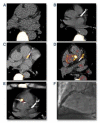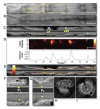The advancing clinical impact of molecular imaging in CVD
- PMID: 24332285
- PMCID: PMC3876961
- DOI: 10.1016/j.jcmg.2013.09.014
The advancing clinical impact of molecular imaging in CVD
Abstract
Molecular imaging seeks to unravel critical molecular and cellular events in living subjects by providing complementary biological information to current structural clinical imaging modalities. In recent years, molecular imaging efforts have marched forward into the clinical cardiovascular arena, and are now actively illuminating new biology in a broad range of conditions, including atherosclerosis, myocardial infarction, thrombosis, vasculitis, aneurysm, cardiomyopathy, and valvular disease. Development of novel molecular imaging reporters is occurring for many clinical cardiovascular imaging modalities (positron emission tomography, single-photon emission computed tomography, magnetic resonance imaging), as well as in translational platforms such as intravascular fluorescence imaging. The ability to image, track, and quantify molecular biomarkers in organs not routinely amenable to biopsy (e.g., the heart and vasculature) open new clinical opportunities to tailor therapeutics based on a cardiovascular disease molecular profile. In addition, molecular imaging is playing an increasing role in atherosclerosis drug development in phase II clinical trials. Here, we present state-of-the-art clinical cardiovascular molecular imaging strategies, and explore promising translational approaches positioned for clinical testing in the near term.
Keywords: (158)Gd-ESMA; (18)F-fluorodeoxyglucose; (18)F-sodium fluoride; AS; AT1R; CAC; CEA; CMR; CT; DVT; FDA; FDG; Food and Drug Administration; ICG; LDL; LV; MI; MMP; MRI; NIRF; NaF; OFDI; OTW; PC; PET; RAAS; SUV; TBR; USPIO; aneurysm; angiotensin II type 1 receptor; aortic stenosis; atherosclerosis; cardiac magnetic resonance; carotid endarterectomy; computed tomography; coronary artery calcium; deep vein thrombosis; gadolinium-labeled elastin-specific magnetic resonance contrast agent; heart failure; high-sensitivity C-reactive protein; hsCRP; indocyanine green; left ventricle/ventricular; low-density lipoprotein; magnetic resonance imaging; matrix metalloproteinase; molecular imaging; myocardial infarction; near-infrared fluorescence; optical frequency domain imaging; over-the-wire; perfusion catheter; positron emission tomography; renin-angiotensin-aldosterone system; standardized uptake value; target-to-background ratio; thrombosis; ultrasmall superparamagnetic particles of iron oxide; valvular disease; vascular injury.
Copyright © 2013 American College of Cardiology Foundation. Published by Elsevier Inc. All rights reserved.
Figures








Similar articles
-
Targeted Near-Infrared Fluorescence Imaging of Atherosclerosis: Clinical and Intracoronary Evaluation of Indocyanine Green.JACC Cardiovasc Imaging. 2016 Sep;9(9):1087-1095. doi: 10.1016/j.jcmg.2016.01.034. Epub 2016 Aug 17. JACC Cardiovasc Imaging. 2016. PMID: 27544892 Free PMC article. Clinical Trial.
-
Contemporary carotid imaging: from degree of stenosis to plaque vulnerability.J Neurosurg. 2016 Jan;124(1):27-42. doi: 10.3171/2015.1.JNS142452. Epub 2015 Jul 31. J Neurosurg. 2016. PMID: 26230478 Review.
-
Measurement of arterial activity on routine FDG PET/CT images improves prediction of risk of future CV events.JACC Cardiovasc Imaging. 2013 Dec;6(12):1250-9. doi: 10.1016/j.jcmg.2013.08.006. Epub 2013 Oct 23. JACC Cardiovasc Imaging. 2013. PMID: 24269261
-
Positron emission tomography for the assessment of myocardial viability: an evidence-based analysis.Ont Health Technol Assess Ser. 2005;5(16):1-167. Epub 2005 Oct 1. Ont Health Technol Assess Ser. 2005. PMID: 23074467 Free PMC article.
-
Targeted Molecular Imaging of Cardiovascular Diseases by Iron Oxide Nanoparticles.Arterioscler Thromb Vasc Biol. 2021 Feb;41(2):601-613. doi: 10.1161/ATVBAHA.120.315404. Epub 2020 Dec 24. Arterioscler Thromb Vasc Biol. 2021. PMID: 33356385 Review.
Cited by
-
Biomimetic nanoparticle technology for cardiovascular disease detection and treatment.Nanoscale Horiz. 2020 Jan 1;5(1):25-42. doi: 10.1039/c9nh00291j. Epub 2019 Jun 28. Nanoscale Horiz. 2020. PMID: 32133150 Free PMC article. Review.
-
In Vivo Aortic Magnetic Resonance Elastography in Abdominal Aortic Aneurysm: A Validation in an Animal Model.Invest Radiol. 2020 Jul;55(7):463-472. doi: 10.1097/RLI.0000000000000660. Invest Radiol. 2020. PMID: 32520516 Free PMC article.
-
Performance Evaluation of a Dedicated Preclinical PET/CT System for the Assessment of Mineralization Process in a Mouse Model of Atherosclerosis.Mol Imaging Biol. 2018 Dec;20(6):984-992. doi: 10.1007/s11307-018-1202-2. Mol Imaging Biol. 2018. PMID: 29713959
-
Quantitative intravascular biological fluorescence-ultrasound imaging of coronary and peripheral arteries in vivo.Eur Heart J Cardiovasc Imaging. 2017 Nov 1;18(11):1253-1261. doi: 10.1093/ehjci/jew222. Eur Heart J Cardiovasc Imaging. 2017. PMID: 28031233 Free PMC article.
-
Targeted Near-Infrared Fluorescence Imaging of Atherosclerosis: Clinical and Intracoronary Evaluation of Indocyanine Green.JACC Cardiovasc Imaging. 2016 Sep;9(9):1087-1095. doi: 10.1016/j.jcmg.2016.01.034. Epub 2016 Aug 17. JACC Cardiovasc Imaging. 2016. PMID: 27544892 Free PMC article. Clinical Trial.
References
-
- Figueroa AL, Subramanian SS, Cury RC, et al. Distribution of inflammation within carotid atherosclerotic plaques with high-risk morphological features: a comparison between positron emission tomography activity, plaque morphology, and histopathology. Circ Cardiovasc Imaging. 2012;5:69–77. - PubMed
Publication types
MeSH terms
Substances
Grants and funding
LinkOut - more resources
Full Text Sources
Other Literature Sources
Research Materials

